
Japanese Knife Types
Japanese knives are known for their unparalleled strength and sharpness compared to other kitchen knives, allowing you to make precise cuts of fish, vegetables, fruit, or sushi rolls. However, Japanese knives come in many shapes, sharpness levels, and sizes, and every type has a specific purpose. We outline the Japanese knife types, the uses for each design, and how to sharpen and care for them. Equipped with the perfect knives, you are well on your way to delighting your guests with perfectly crafted sushi.
Shop All Japanese Knives
Use the following links to explore different types of Japanese knives:
One of the most common Japanese knife types is the Santoku knife, a multi-purpose knife perfect for sushi operations. Because of their general-purpose usage, Santoku knives can easily be confused with chef's knives. Both kinds usually have a double bevel and feature a Granton edge. Santoku and chef knives have several anatomical differences that set the Santoku knife apart from its western counterpart.
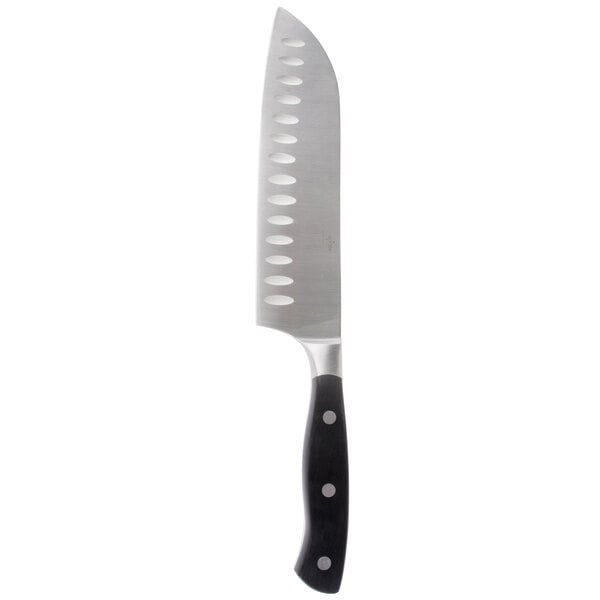
Santoku Knives
Santoku knives are thinner and shorter than chef’s knives, allowing for more precision while slicing food items. As a result of these features, santoku knives are lighter and more balanced than their counterpart. It also does not have a tip or a bolster.
- Single (one-sided) or double (two-sided) bevel
- May feature a Granton edge
- 5" - 8" long blade
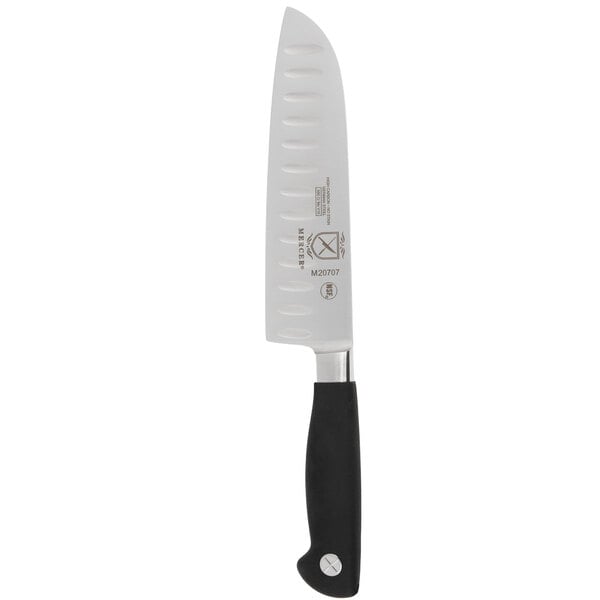
Chef's Knives
Unlike Santoku knives, chef’s knives have a tip that allows the user to rock the blade as they cut ingredients. The design is heavier and longer than the sushi knife, with a broad blade and a thick spine. It also has a bolster and options for a serrated edge.
- Usually has a double bevel
- May feature a Granton edge
- 6" - 12" long blade
Japanese knives traditionally feature a high-carbon steel construction refined by acclaimed Japanese swordsmithing techniques to make them sharper, lighter, and more solid than stainless steel knives. Smiths crafted many Japanese swords using this same high-carbon steel.
Japanese knives have a high rating on the Rockwell Hardness Scale (HRC), the industry standard for measuring the hardness of steel. Therefore, you can sharpen Japanese knives to a much sharper and finer angle. The sharp edge also leads to greater ease in cutting, thus minimizing pressure on the muscles and joints in your hand. For this reason, many chefs prefer Japanese knives to stainless steel alternatives. Japanese knives' sharp bevel and thin construction make them ideal for making precise slices of vegetables, fish, and sushi rolls.
Figuring out which Japanese knives to implement in your kitchen can be confusing. We break down the various types of Japanese knives so you can make an informed decision.
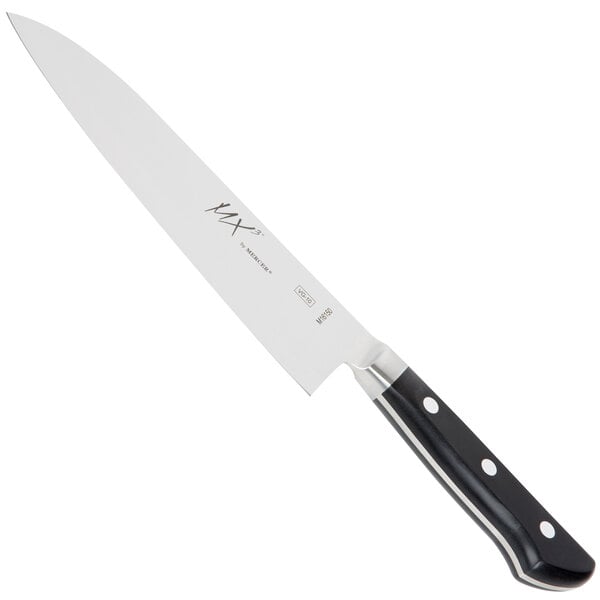
Santoku Knife
The Japanese word “Santoku” can be translated as “three virtues,” as this knife is ideally used for three main functions: chopping, slicing, and dicing.
- Multi-purpose, Western-style knife
- Can be used to cut raw fish, meat, and vegetables
- The blade does not culminate into a tip
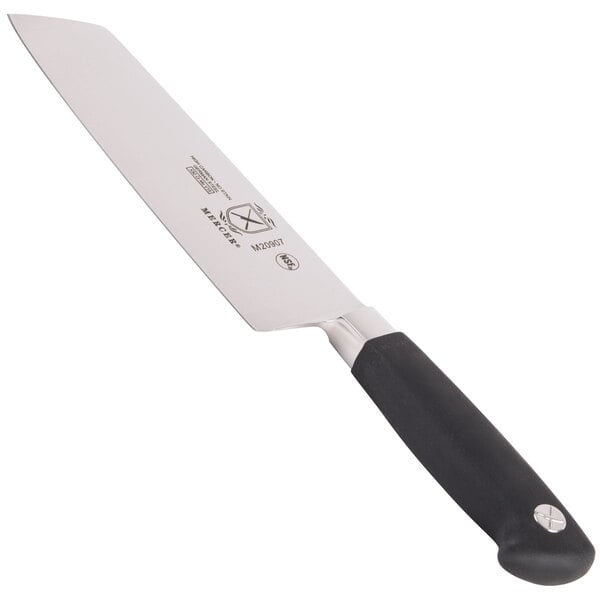
Nakiri Knife
With a rectangular blade, the Nakiri knife slices and dices fruits and vegetables into thin, uniform slices to add to sushi rolls.
- Design allows for clean chops of fruits and vegetables
- Full tang increases safety and reduces the risk of injury
- Long and straight blade design allows for easy slicing
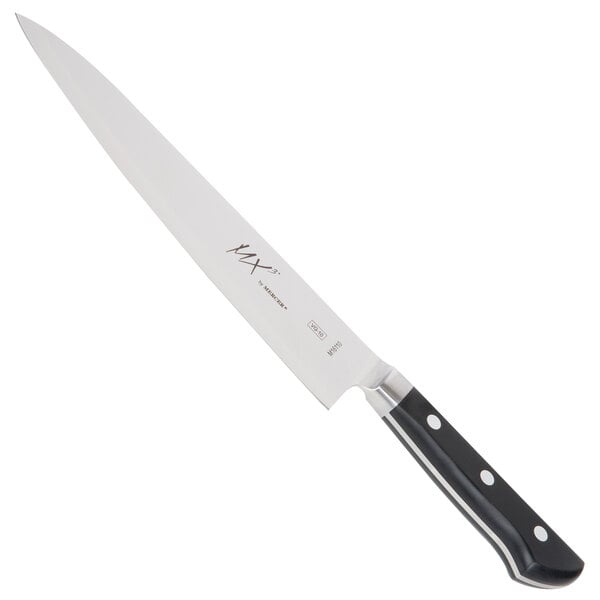
Gyuto Knife
Sharing many similarities to chef knives, a Gyuto knife's light, thin construction allows it to make clean slices of fruits, vegetables, or meats.
- Flat edge allows for quick cuts and easy handling
- Well-suited for making precise cuts and working in tight spaces
- Design makes it an ideal multi-purpose knife
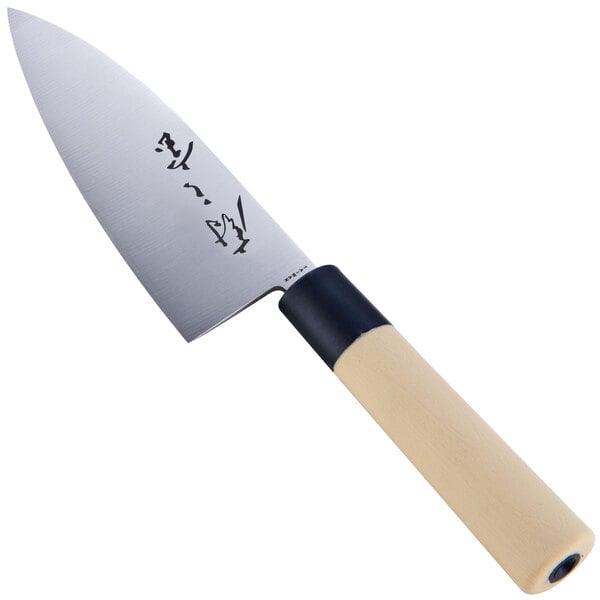
Deba Knife
Also used to chop vegetables and cube meats, chefs commonly use a Deba knife to carve cuts of fish. Its versatility makes it a valuable addition to any sushi restaurant.
- Light- or medium-duty cleaver
- Flat edge prevents food from sticking to the knife
- Strong enough to cut through cartilage and bones
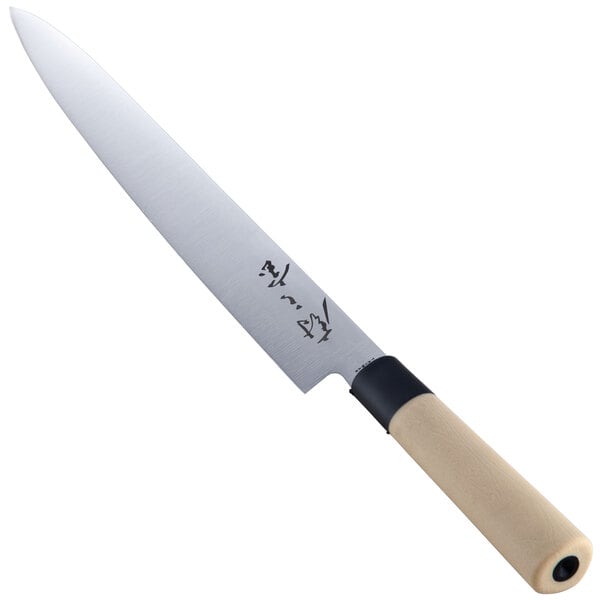
Sashimi Knife
Characterized by their long, thin blades, Sashimi knives can cut many types of ingredients. They are ideal for making precise cuts of raw fish for sushi without tearing them.
- Straight, smooth edge
- Comparable to a Western-style slicing knife
- Long blade is well-suited for carving large cuts of fish
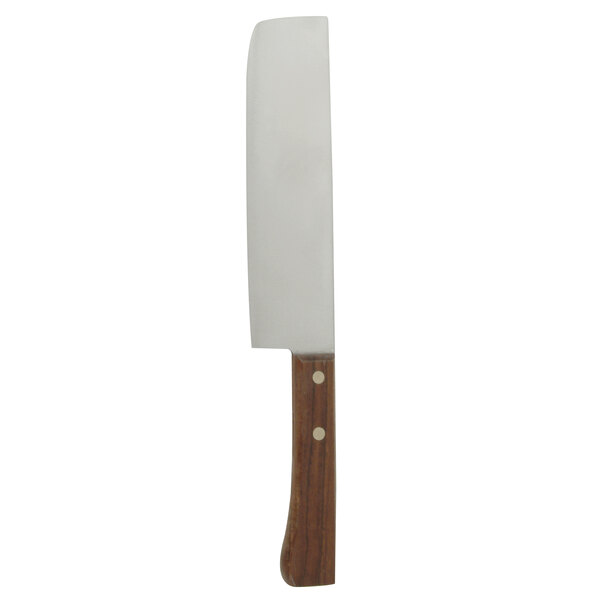
Usuba Knife
Translated from Japanese as “thin blade,” the Usuba knife chops vegetables into uniform slices. The thin blade causes minimal cell damage to food, thus reducing the discoloration and change in flavor resulting from oxidation.
- Single bevel
- Ideal for making fine cuts
- Not recommended to cut fruits and vegetables with hard skins
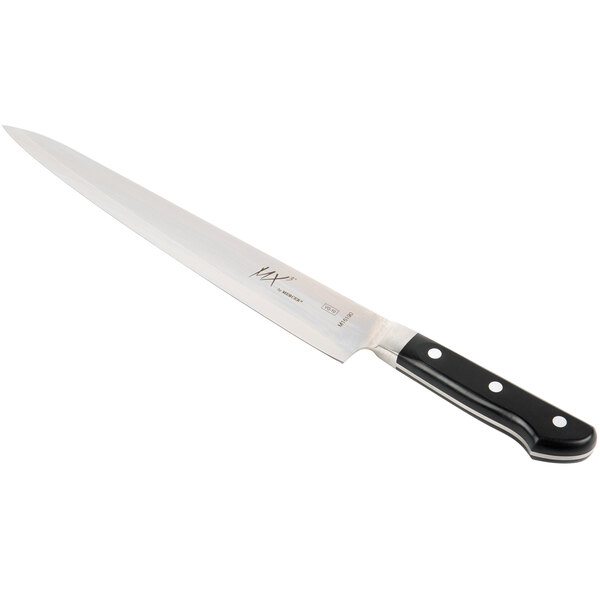
Sujihiki Knife
Comparable to a Western slicing knife, the Sujihiki knife’s straight, smooth blade is perfect for carving boneless cuts of meat.
- Short blade height creates less friction when slicing
- Long blade length simplifies the process of peeling away excess fat or skin
- Ideal for executing clean slices, eliminating sawing
One significant difference between Japanese and German knives lies in the hardness of their blades. Japanese blades have a higher Rockwell Hardness Scale rating, ranging between 58-66 HRC. This rating means they are harder than German knives but more brittle and prone to chips and breakage. On the other hand, German knives have softer steel with a lower rating between 52-56 HRC. These blades are more resistant to damage, but they require frequent sharpening.
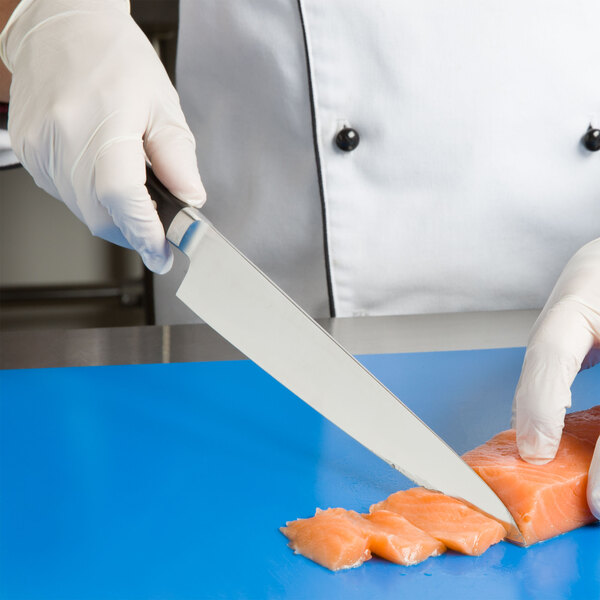
Japanese Knives
While they share several anatomical qualities, Japanese knives are characterized by a fine edge for delicate slicing and making precise cuts of tender foods like fish. Their high-carbon steel construction is honed and refined by hand.
- Lighter for more controlled movements
- Smaller blade angle of roughly 10-15 degrees makes clean cuts without damaging food
- Straight blade for clean, precise cuts
- No bolster and blades that taper inside the handle for a more versatile, lightweight blade and more controlled movements
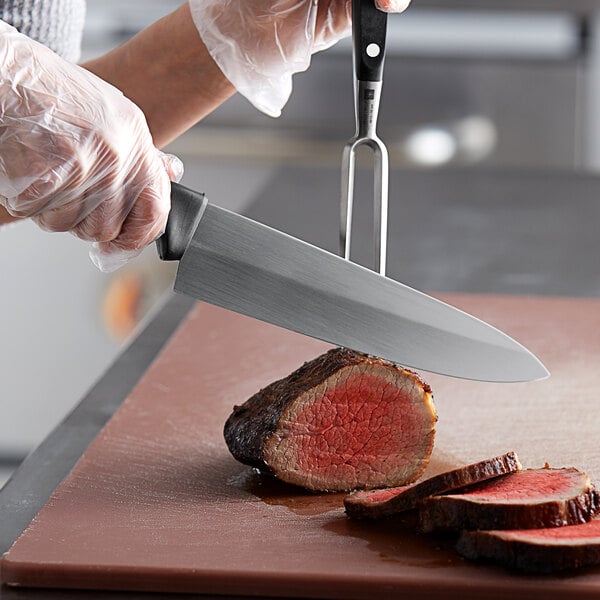
German Knives
More familiar to Western culture, German knives are crafted from stainless steel with durability in mind. The thick blade handles tougher cuts without getting damaged, making them ideal for butcher shops. Typically, these knives are finished with a machine rather than by hand.
- Heavier for increased durability
- Larger blade angle of about 20 degrees is designed to cut through tough foods
- Curved blade for making cuts in a rocking motion
- Full tang and bolster for elevated strength and balance, reducing the risk of workplace injury
Because high-carbon steel is harder than stainless steel, Japanese blades require less frequent sharpening than Western knives. When sharpening your Japanese knife, use a whetstone, and avoid honing rods, steels, or any other kind of sharpening device. Follow these steps to achieve a clean, sharp edge:
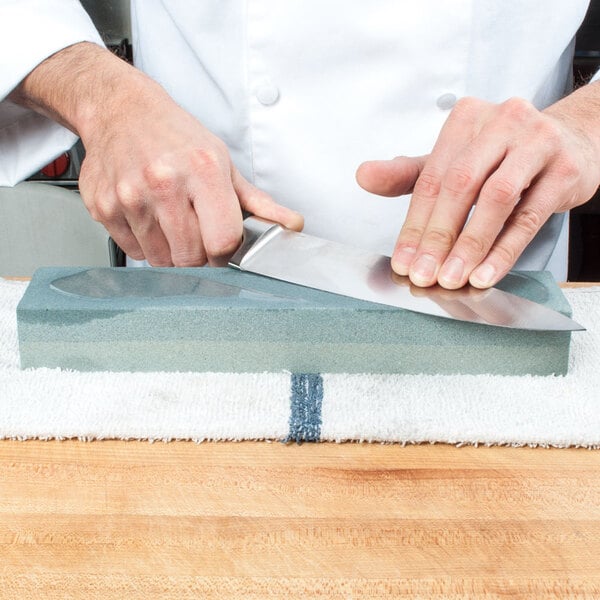
- Submerge a whetstone in water for 10-15 minutes or until air bubbles stop surfacing.
- Place the whetstone on a solid surface to ensure it stays still while sharpening.
- Holding the knife at a 10-15 degree angle, move it along the whetstone from heel to toe.
- Repeat this step 5-10 times on each side of the knife.
- Reverse directions and push the knife toe to heel, repeating 5-10 times on both sides.
- Strop, or brush, the blade on jeans, newspaper, or leather to realign the edge.
Note: Single-beveled Japanese knives, such as Deba knives and some Santoku knives, are only sharpened on one side.
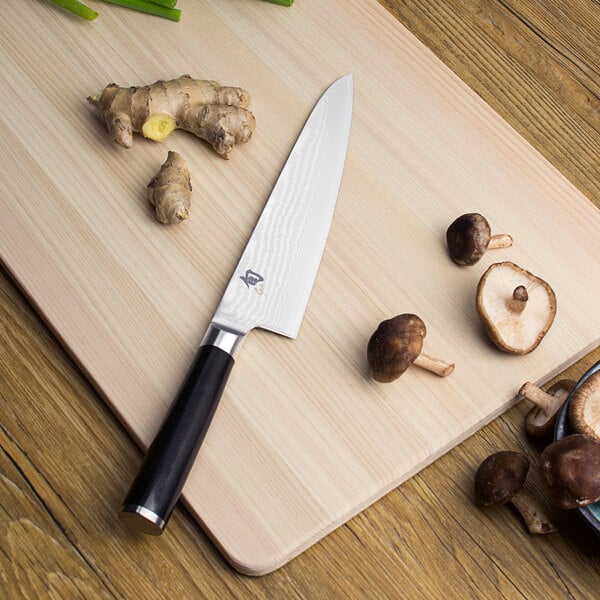
The high-carbon steel blades of Japanese sushi knives are more prone to rust than stainless steel alternatives, which affects the life of the knife and your ability to use the knife safely. To avoid rusting, wash and dry the knife immediately after use. If needed, add a small amount of oil to the blade for an added layer of protection.
Also, remember that Japanese knives are not dishwasher safe, as the heat, water, and chemicals can damage the blade and handle. To preserve your knives, hand-wash them with mild soap and warm water. Here are some additional tips for your Japanese knives:
- Avoid using Japanese knives to cut acidic foods, as this can change the color, taste, or smell of the food
- Avoid cutting extremely hard or frozen items with your knife, as this may cause chipping or breakage to the blade
- Never use the knife on a metal or glass surface. For best results, use an end-grain wooden cutting board
Related Resources
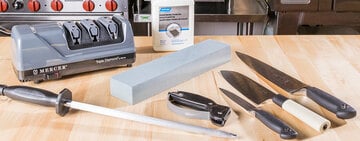
Knife Sharpeners Buying Guide
No matter what type of knife you own, it's essential to keep it sharp for the best results. Sharp knives make food prep easier and require less pressure to achieve your desired cuts, contributing to a safe kitchen environment . If you aren't familiar with knife sharpeners, it can be difficult to determine the sharpener that best fits your needs. In this guide, we'll introduce the different types of sharpeners, bevels, and knife angles so that you can make an informed decision. Shop All Knife Sharpeners Use the following links to learn more about the types of knife sharpeners: Electric Knife Sharpeners Sharpening Stones Sharpening Steels Serrated Knife Sharpeners Handheld Knife Sharpeners
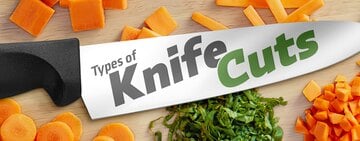
Types of Knife Cuts
Restaurant kitchens write their recipe cards with the knife cut sizes in mind, so you must learn how to perform the classic culinary knife cuts to become a chef . Skillful knife cuts aren't just about presentation; they ensure food cooks evenly, enhance texture, and release aroma. Whether you're considering attending culinary school or want to move up the kitchen hierarchy , use our types of knife cuts guide to brush up on the basics. Click any of the links below to skip to the type of knife cut that most interests you: Dice Julienne Mince Chiffonade Chop Brunoise Rondelle Batonnet Paysanne Knife Cutting Techniques Different Knife Cuts Discover the essential knife cuts used in the culinary arts. From functional to decorative, each of these
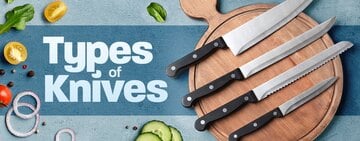
Types of Knives
Knives are the most important tool in a chef's kit, and they can be used for just about any food prep task from chopping onions and butchering a cut of beef to opening oysters and slicing bread. But, there are different types of kitchen knives that are designed for various purposes. This comprehensive guide covers the types of knives and their uses, so you can find the right option for your needs. Shop All Kitchen Knives Use the following links to navigate and learn about the different types of knives: Kitchen Knife Types Types of Table Knives Parts of a Knife Carbon Steel vs Stainless Steel Knives Forged vs Stamped Knives Types of Knife Edges Knife Handle Styles Knife Maintenance Kitchen Knife Storage
- Topics 1346
- Industrial 55
- Troubleshooting Guides 21
- Restaurant Management 128
- Bar Management 55
- Catering Tips 35
- Bakery Management 42
- Food Trucks & Concessions 49
- Advertising & Marketing 37
- Eco-Friendly Tips 11
- Facility Layout & Design 41
- Coffee Shop Tips 28
- Installation & Maintenance 51
- Janitorial & Pest Control 30
- Safety & Sanitation 88
- Startup Tips 104
- Menu Design 10
- Kitchen & Cooking Tips 81
- Hospitality Management 23
- Pizza & Sandwich Shop Tips 36
- Smallwares 37
- Food Prep 88
- Tabletop Items 17
- Disposables 22
- Calculators & Tools 6
- Consumables 52
- Warewashing & Laundry 18
- Cooking Equipment 90
- Food Storage & Refrigeration 51
- Beverage Equipment 34
- Office Supplies 6
- Resource Type
- In-Depth Articles272
- Buying Guides296
- How-Tos93
- Product Reviews77


